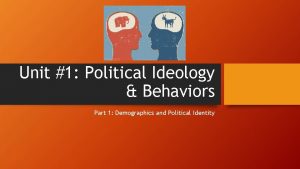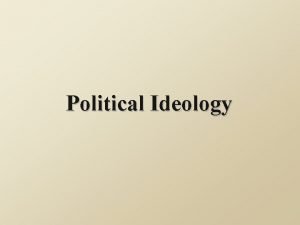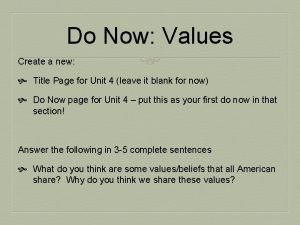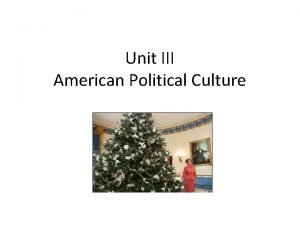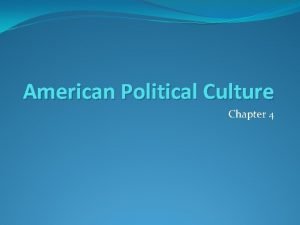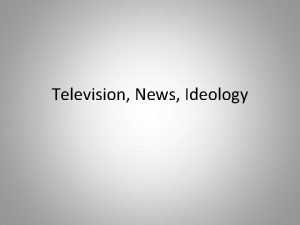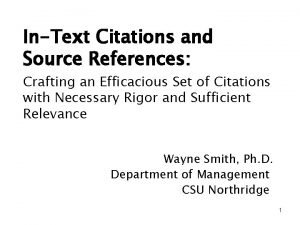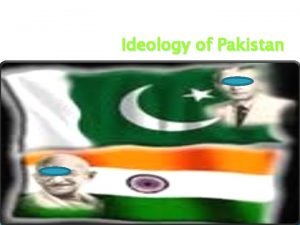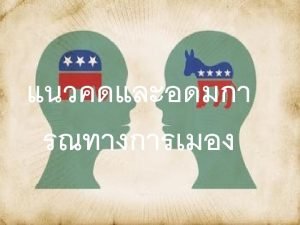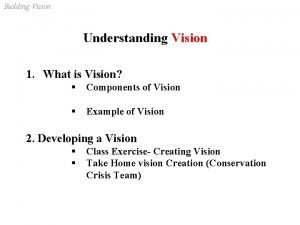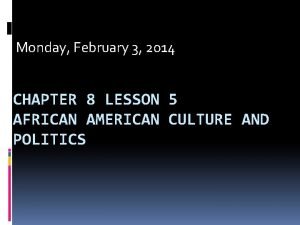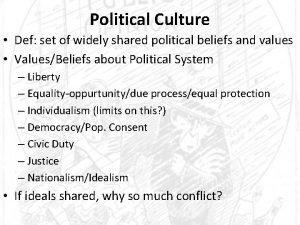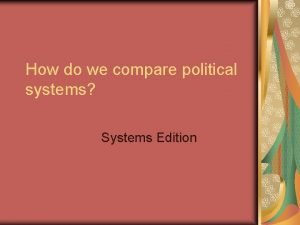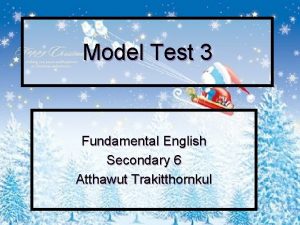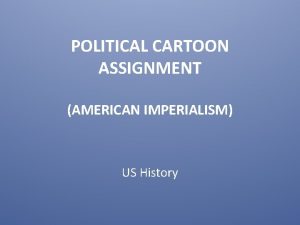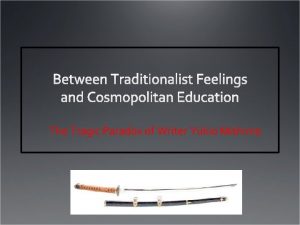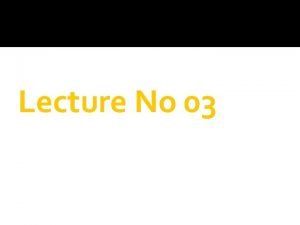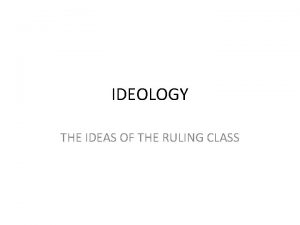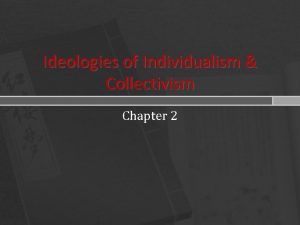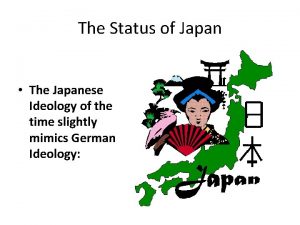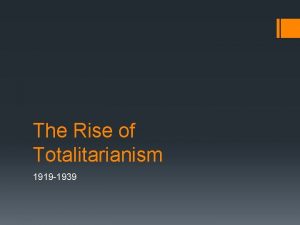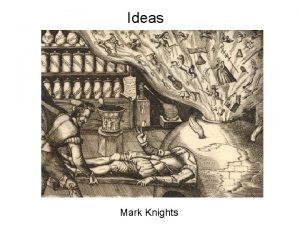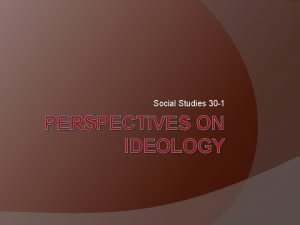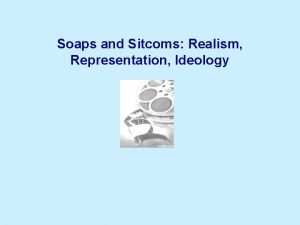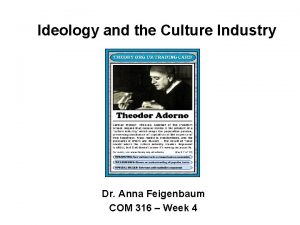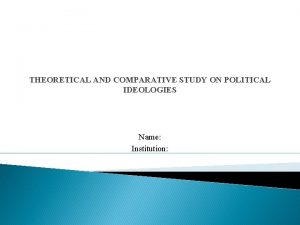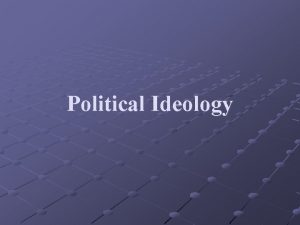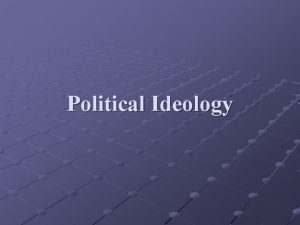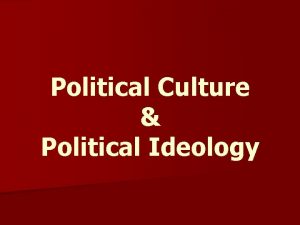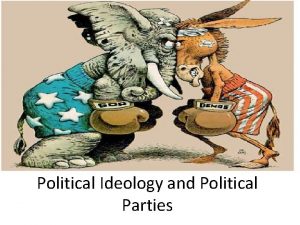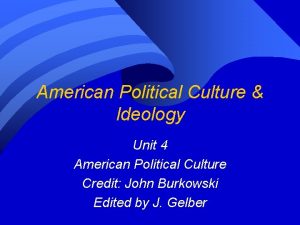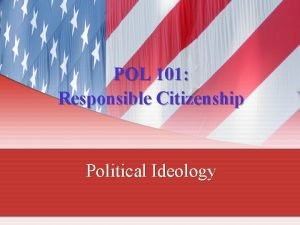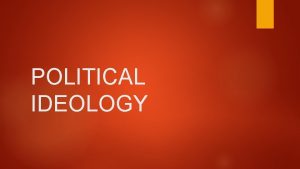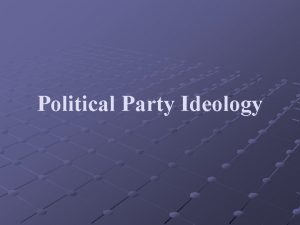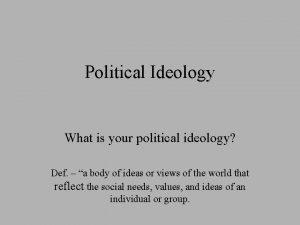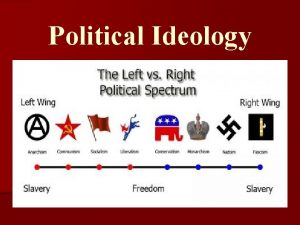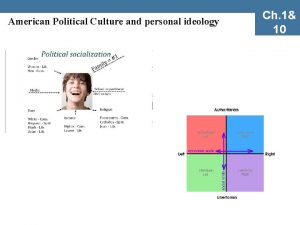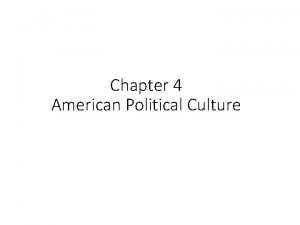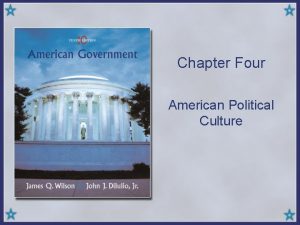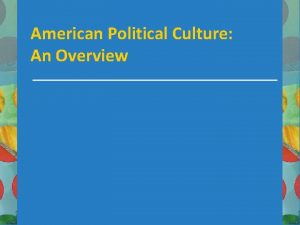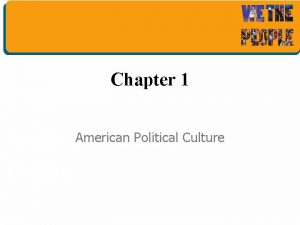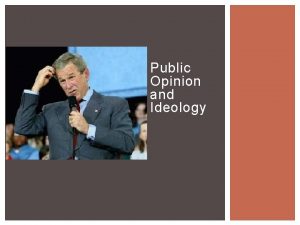American Political Culture and personal ideology Ch 1






















































- Slides: 54

American Political Culture and personal ideology Ch. 1& 10

American Political Culture and the Basic Tenets of American Democracy 1. 4 ¤ Liberty and Equality ¤ Popular Consent, Majority Rule, and Popular Sovereignty ¤ Individualism ¤ Religious Faith and Religious Freedom

Popular Consent, Majority Rule, and Popular Sovereignty ¤ Popular consent n Governments derive power by consent of the governed ¤ Majority rule n Bill of Rights protects minority rights ¤ Popular sovereignty n Natural law 1. 4

Individualism ¤ Unique to American democracy ¤ Traced to Puritans ¤ Linked to unalienable rights 1. 4

Religious Faith and Religious Freedom 1. 4 ¤ Religious conflict motivation for immigration ¤ Colonists sought freedom of religion n Did not want to grant it to others ¤ Religious freedom enshrined in Constitution n Tolerance still more of an ideal

The Changing American Public ¤ ¤ ¤ Racial and Ethnic Composition Aging Religious Beliefs Regional Growth and Expansion Family and Family Size 1. 5

Racial and Ethnic Composition ¤ Immigration from Eastern Europe ¤ Growth of Hispanic population ¤ Minorities now the majority 1. 5

Figure 1. 2 How does population affect representation? 1. 5

Aging ¤ Strain on Social Security ¤ Impact on working Americans 1. 5

Religious Beliefs ¤ No longer so uniform ¤ Different political and social demands 1. 5

Regional Growth and Expansion ¤ North versus south ¤ Anti-government bias of West 1. 5


Family and Family Size ¤ Gender roles ¤ Declining marriage rate ¤ Same sex marriage 1. 5

Political Ideology ¤ What Is a Political Ideology? ¤ Finding Your Political Ideology ¤ Problems with Ideological Labels 1. 6

What Is a Political Ideology? ¤ Four functions of ideologies: n Explanation n Evaluation n Orientation n Political program 1. 6

Finding Your Political Ideology ¤ Conservatives n Social conservatives ¤ Liberals ¤ Moderates 1. 6

FIGURE 1. 3: What are Americans’ political ideologies? 1. 6

Problems with Ideological Labels ¤ Is left-to-right the only direction? ¤ Economic versus personal liberties 1. 6

Forming Political Opinions ¤ ¤ ¤ Demographic Characteristics Family, Peers, and School The Mass Media Cues from Leaders or Opinion Makers Political Knowledge 10. 3

Demographic Characteristics ¤ Gender n Women historically more liberal than men 10. 3

TABLE 10. 1: Do men and women think differently about political issues? 10. 3

Political Gender Gap

Demographic Characteristics ¤ Urban vs. Rural ¤ Race and ethnicity n Differences among and within races and ethnicities ¤ Age affects political socialization ¤ Religion shapes political beliefs 10. 3

Family, Peers, and School ¤ Family influence n Children learn political beliefs at early age ¤ Peers are influential in middle or high school ¤ Political socialization in school 10. 3

The Mass Media ¤ Traditional news sources n Americans are turning away from them ¤ Nontraditional news media n Talk radio, online magazines, blogs ¤ Cable and Internet n Often skewed 10. 3

Cues from Leaders or Opinion Makers ¤ Political leaders use media to influence public ¤ President uses media as a bully pulpit 10. 3

Public Opinion and the News Media 10

Political Knowledge ¤ Political knowledge and political participation n Have a reciprocal effect on each other ¤ Americans’ level of civic knowledge n Lower than 50 years ago 10. 3

Public Opinion Polling

The Earliest Public Opinion Research ¤ Polling to predict winner of elections ¤ Polling to discover public opinions n Walter Lippmann’s Public Opinion ¤ Literary Digest n Straw poll n Sample 10. 1

The Gallup Organization ¤ George Gallup n Dissertation on how to measure the readership of newspapers n Expanded research to study public opinion about politics ¤ Increased use of polling to market products and candidates 10. 1

FIGURE 10. 1: How successful has the Gallup Poll been? 10. 1

Conducting and Analyzing Public Opinion Polls ¤ ¤ Designing the Survey and Sample Contacting Respondents Analyzing the Data Shortcomings of Polling 10. 2

10. 1

Designing the Survey and Sample 10. 2 ¤ Determining the content and phrasing of the questions n Wording is crucial n “Push polls” ¤ Selecting the sample n Population n Random sampling n Stratified sampling

Contacting Respondents ¤ Telephone polls n Random digit dialing survey n Tracking polls 10. 2

Contacting Respondents ¤ In-person interviews n Exit polls ¤ Internet polls n Scientific polls versus unscientific Web polls 10. 2

FIGURE 10. 2: What does a daily tracking poll look like? 10. 2

Analyzing the Data 10. 2 ¤ Reveals implications for public policy and political campaigns ¤ Data analyzed by computers n Subgroups of population, such as men versus women, age groups, or political ideology, may be analyzed ¤ Margin of error n Natural errors in statistical measurement, typically 4% ¤ Sampling error n Small samples can be accurate IF drawn correctly

Shortcomings of Polling ¤ ¤ Limited respondent options Lack of information Difficulty measuring intensity Lack of interest in political issues 10. 2

Can polls measure intensity of opinion? 10. 2

Roots of the News Media in the United States ¤ Print Media ¤ Radio News ¤ TV News ¤ Online Media ¤ Current News Media Trends ¤ Citizen Journalists 10. 4

Current News Media Trends: Corporate Ownership and Media Consolidation ¤ Private ownership = independence n For-profit business n Pressure to consolidate, eliminate competition ¤ Risks of consolidation n Limit flow of information n Focus on what sells n Please advertisers 10. 4

Narrowcasting ¤ Targeting specific populations ¤ News audiences divided along partisan lines ¤ Appeals to preexisting views 10. 4

Infotainment ¤ Blending information and entertainment ¤ Political leaders use these shows Reach larger audiences Humanize politician ¤ Audience sophistication matters 10. 4

Increasing Use of Experts ¤ Talking heads fill airtime ¤ Who are these experts? Officials, consultants, former politicians, academics, etc. ¤ Influence on the public Lack of objectivity Weaken democratic deliberation 10. 4

Citizen Journalists ¤ Ordinary individuals n Collect, report, and analyze n Post content not covered n Provide on the scene coverage n Cheaper than hiring reporters ¤ Problems with amateur reporting n Lack of objectivity n Quality varies 10. 4

Government Regulations 10. 5 ¤ Libel and slander are illegal ¤ Prior restraint n New York Times v. U. S. (1971) ¤ Electronic media regulated more heavily n Airwaves are public property n Limited supply ¤ Media ownership n Telecommunications Act (1996) ¤ Content n Equal time rule

Covering the Presidency ¤ Receives most media coverage ¤ Prestigious post for a reporter ¤ Daily Q&A with press secretary 10. 6

Covering Congress ¤ Logistical challenge n 535 members ¤ Focus on party leaders n Majority and minority leaders in both houses n Whips ¤ Key committee chairs ¤ Coverage is negative n Focus on scandals and conflict 10. 6

Covering the Supreme Court ¤ Media vacuum n n TV cameras not permitted Few reporters cover Court Complex legal issues harder to present Justices rarely grant interviews 10. 6

News Media Influence ¤ Media effects n Influencing public opinion ¤ Agenda setting n Influence issues addressed by government ¤ Framing n How an issue is portrayed affects how it is perceived n Greater influence on foreign policy n Less personal experience 10. 7

News Media Bias ¤ Journalists are biased n Values, preferences, attitudes ¤ How are news media biased n Elite bias n Dramatic bias ¤ News media stardom 10. 7

Public Confidence ¤ Assessment unfavorable n Inaccurate n Biased n Rich and powerful influence coverage ¤ Valuable watchdog role 10. 7
 Difference between american and indian culture
Difference between american and indian culture Ap gov unit 4 political ideologies and beliefs
Ap gov unit 4 political ideologies and beliefs Whats political ideology
Whats political ideology Political ideology
Political ideology What is ideology
What is ideology Political ideology
Political ideology Political ideology
Political ideology Political ideology definition
Political ideology definition American political culture definition
American political culture definition American political culture definition
American political culture definition Cultural relativism definition
Cultural relativism definition Fed-batch
Fed-batch Uses of selenite f broth
Uses of selenite f broth Folk culture and popular culture venn diagram
Folk culture and popular culture venn diagram Chapter 4 folk and popular culture
Chapter 4 folk and popular culture Urease test
Urease test Homework due today
Homework due today Pour plate method
Pour plate method Carpet culture microbiology
Carpet culture microbiology Surface culture deep culture and esol
Surface culture deep culture and esol Discourse and ideology
Discourse and ideology Difference between theory and ideology
Difference between theory and ideology Components of pakistan ideology
Components of pakistan ideology Soup and ideology
Soup and ideology Sony mission statement 1950
Sony mission statement 1950 Lesson 5 african american culture and politics
Lesson 5 african american culture and politics Political culture def
Political culture def Is texas in the bible belt
Is texas in the bible belt What is political culture
What is political culture If a ruby is heated it temporarily lose its color
If a ruby is heated it temporarily lose its color American imperialism political cartoons explained
American imperialism political cartoons explained What does the picture depict
What does the picture depict American political spectrum
American political spectrum Individual culture traits combine to form culture patterns.
Individual culture traits combine to form culture patterns. Batch culture vs continuous culture
Batch culture vs continuous culture Collectivistic cultures
Collectivistic cultures Vocational subculture
Vocational subculture In an inert organizational culture,
In an inert organizational culture, Laying the foundation for a quality culture
Laying the foundation for a quality culture Thermos hiraoka
Thermos hiraoka Masculinity ideology
Masculinity ideology Significance of ideology
Significance of ideology Ruling class ideology
Ruling class ideology Okja definition
Okja definition Principles of individualism
Principles of individualism Goth ideology
Goth ideology Economic equality meaning
Economic equality meaning Japanese ideology
Japanese ideology Hitler ideology
Hitler ideology Ideology
Ideology Machiavelli ideology
Machiavelli ideology Perspectives on ideology
Perspectives on ideology What is idealism and realism
What is idealism and realism Ideology
Ideology Conservative comparative and superlative
Conservative comparative and superlative



